Nof S.Y. Springer Handbook of Automation
Подождите немного. Документ загружается.

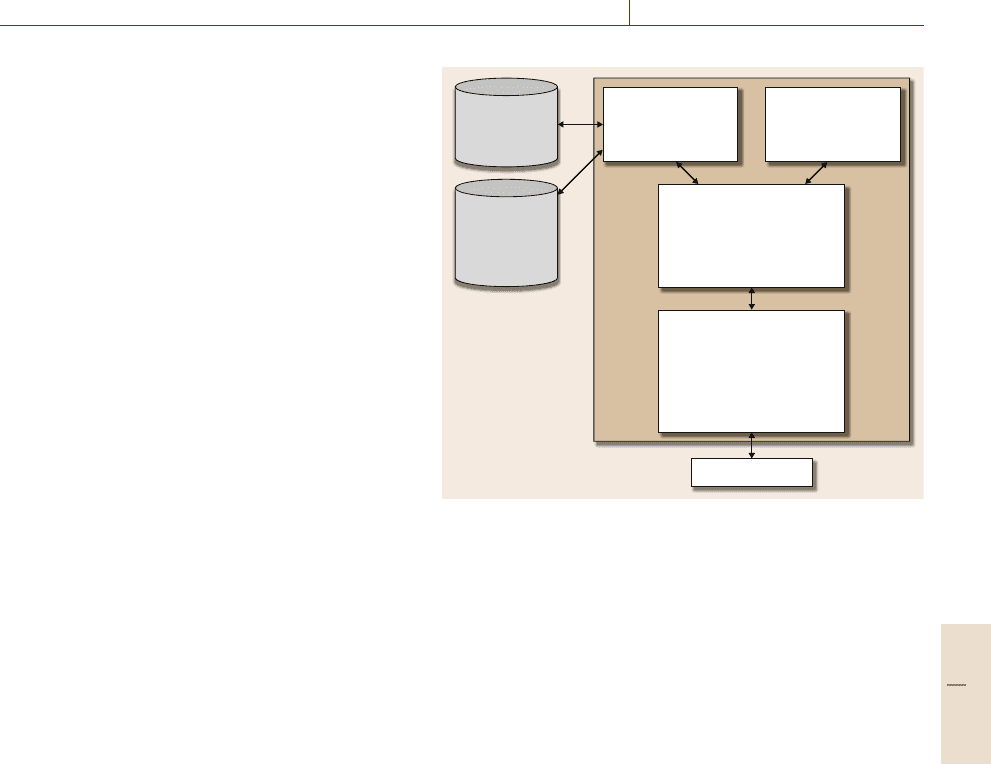
Decision Support Systems 87.2 Building Decision Support Systems 1545
empirical evidence indicate that design and implemen-
tation issues vary for data-driven, document-driven,
model-driven, and knowledge-driven DSS. Multipar-
ticipant systems such as group and interorganizational
DSS also create complex implementation issues. For
instance, when implementing a data-driven DSS ade-
signer should be especially concerned about the user’s
interest in applying the DSS in unanticipated or novel
situations.
In creating an accounting or financial simulation
model, a developer should attempt to verify that the ini-
tial input estimates for the model are thoughtful and
reasonable. In developing a representational or opti-
mization model, an analyst should be concerned about
possible misunderstandings of what the model means
and how it can or cannot be used [87.5]. Networking
issues create challenges for many types of DSS,butes-
pecially for communications-driven systems with many
participants, so-called multiparticipant systems. Today,
architecture and networking issues are increasingly im-
portant in building DSS.
DSS should be built or implemented using an
appropriate process. Many small, specialized model-
driven DSS are built quickly. Large, enterprise-wide
DSS are built using sophisticated tools and systematic
and structured systems analysis and development ap-
proaches. Communications-driven and group DSS are
usually purchased as off-the-shelf software and then
implemented in a company. Creating enterprise-wide
DSS environments remains an iterative and evolution-
ary task. An enterprise-wide DSS grows and inevitably
becomes a major part of the overall information systems
infrastructure of an organization. Despite the signifi-
cant differences created by the specific task and scope
of a DSS,allDSS have similar technical components
and share a common purpose: supporting decision-
making.
A data-driven DSS database is often a collection of
current and historical structured data from a number of
sources that have been organized for easy access and
analysis. We are expanding the data component to in-
clude unstructured documents in document-driven DSS
and knowledge in the form of rules in knowledge-driven
DSS. Large databases of structured data in enterprise-
wide DSS are often called data warehouses or data
marts. DSS usually use data that has been extracted
from all relevant internal and external databases. Man-
aging information often means managing a database.
Supporting management decision-making means that
computerized tools are used to make sense of the struc-
tured data or documents in a database.
External data
• Dow Jones
• Reuters
Database component
• Knowledge
• Data
• Documents
Model component
• Inference engine
• Models
Communications component
• DSS architecture
• Network
• Web server
• Client/server
• Main frame
User interface component
• Dialog
• Maps
• Menus, icons
• Representations
• Charts, graphs
• Web browser
Users
Internal data
• Personnel
• Production
• Finance
• Marketing
Fig. 87.1 Traditional DSS components [87.1]
Mathematical and analytical models are the ma-
jor component of a model-driven DSS. DSS models
should be used and manipulated directly by managers
and staff specialists. Each model-driven DSS has a spe-
cific set of purposes and hence different models are
needed and used. Choosing appropriate models is a key
design issue. Also, the software used for creating spe-
cific models needs to manage needed data and the
user interface. In model-driven DSS the values of key
variables or parameters are changed, often repeatedly,
to reflect potential changes in supply, production, the
economy, sales, the marketplace, costs, and/or other en-
vironmental and internal factors. Information from the
models is then analyzed and evaluated by the decision-
maker. Knowledge-driven DSS use special models, an
inference engine, for processing rules or identifying re-
lationships in data.
The communications component refers tohowhard-
ware is organized, how software and data are distributed
in the system, and how components of the system
are integrated and connected. A major issue today is
whether decision support systems should be available
using a web browser on a company intranet and also
available on the global Internet. Managers and infor-
mation systems (IS) staff both need to develop an
understanding of the technical issues and the security
issues related to DSS architectures, networks, and the
Internet. Networking technology is the key driver of
communications-driven DSS.
Part I 87.2
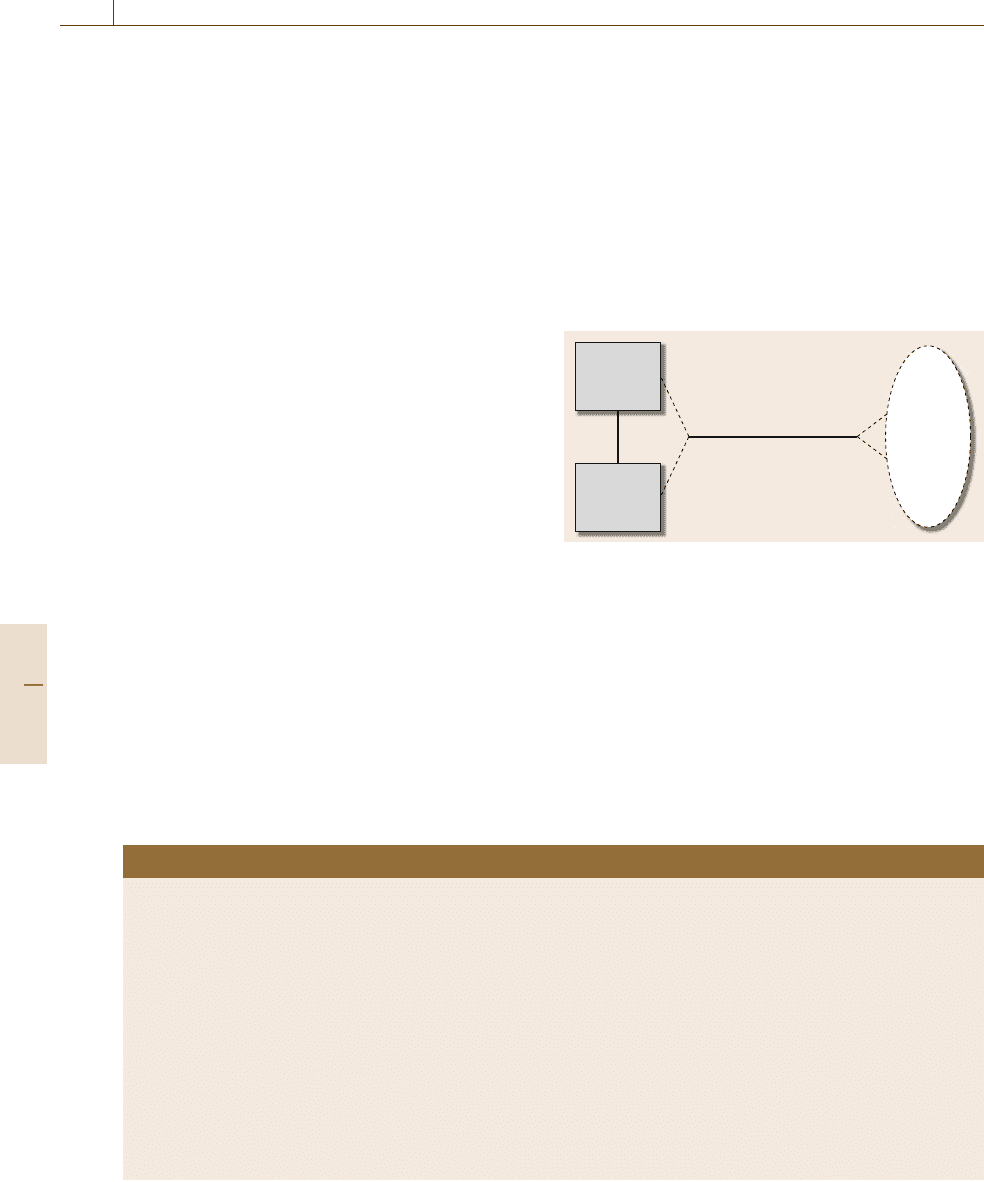
1546 Part I Home, Office, and Enterprise Automation
Managers and DSS analysts both need to emphasize
the user interface component. In many ways the user in-
terface is the most important component. The tools for
building the user interface are sometimes termed DSS
generators, query and reporting tools, and front-end
development packages. Much of the DSS design and
development effort should focus on building the user
interface. It is important to remember that the screens
and displays in the user interface heavily influence how
a manager perceives a DSS, as what one seesis theDSS.
The technologies and software associated with de-
cision support systems continues to change rapidly,
and development tools are overlapping for some ap-
plications. In general, managers and IS staff need to
recognize that the overall technological and social con-
text of DSS and business management is changing.
87.3 DSS Architecture
Many academics discuss building decision support sys-
tems in terms of the four major components (Fig.87.2).
These components collectively comprise the overall
architecture of a DSS. This traditional view of DSS
components remains useful because it identifies com-
monalties between different types of DSS, but it pro-
vides only an initial perspective for understanding the
complexity of DSS architectures.
As noted in the last section, a major component in
the architecture of a DSS is the user interface. The tools
for building the user interface are sometimes termed
DSS generators, query and reporting tools, and front-
end development packages. DSS user interfaces can be
distributed to clients in a thick-client architecture or de-
livered over a network using web pages or Java applets
in a thin-client architecture. A thin-client architecture
where a user interacts using a web browser has many
advantages, but until recently the sophistication of the
user interface was limited compared with a thick-client
architecture where a program resides on a DSS user’s
computer.
Table 87.3 Selected resources for DSS
Resource Type Exemplars
Organizations SIG DSS
http://sigs.aisnet.or
Websites www.dssresources.com
(contains links to most other DSS resources)
Journals Decision Support Systems, Management Science, Decision Sciences, and many others
Books S.B. Eom: The Development of Decision Support Systems Research: A Bibliometrical
Approach (Edwin Mellon, New York, 2007)
D.J. Power: Decision Support Systems Hyperbook, http://dssresources.com/dssbook/
(Fall, 2000)
Turban, Aronson, Liang, Sharda: Decision Support and Business Intelligence Systems,
8th ed. (Prentice Hall, Upper Saddle River 2007)
Model
management
server
Network
User
interface
Client
computer
Data
server
Fig. 87.2 DSS components (after [87.1])
A DSS database is a collection of data orga-
nized for easy access and analysis. Large databases
in enterprise-wide DSS are often called data ware-
houses or data marts. Document or unstructured data
is stored differently than structured data. Web servers
provide a powerful platform for unstructured data and
documents. The architecture for a data-driven DSS of-
ten involves databases on multiple servers, specialized
hardware, and in some cases both multidimensional and
Part I 87.3

Decision Support Systems 87.5 Further Reading 1547
relational database software. The extraction, transfor-
mation, loading, and indexing of structured DSS data
is sometimes very difficult.
As noted before, quantitative models are an im-
portant part of many DSS, especially model-driven
DSS. Model management software can be centralized
on a server with a database, or specific models can
be distributed to client computers. Java applets and
JavaScript programs provide a powerful new means
to deliver models to users in a thin-client architec-
ture.
The DSS network component refers to how hard-
ware is organized, how software and data are distributed
in the system, and how components of the DSS are in-
tegrated and physically connected. An ongoing issue is
whether a specific DSS should only be available using
thin-client technology on a company intranet or avail-
able on the global Internet. This should depend on the
needs analysis and a feasibility study. Scalability is also
an important DSS issue. Scalability refers to the abil-
ity to scale hardware and software to support larger
or smaller volumes of data, and more or fewer users.
Scalability also refers to the possibility of increasing or
decreasing size or capability of a DSS in cost-effective
increments.
Table 87.3 provides selected additional readings
and other resources for exploring DSS applications and
technologies. These include web resources, text books,
and selected journal articles in addition to those in-
cluded in the references.
87.4 Conclusions
The DSS design and development environment is
changing as rapidly as the innovation in hardware and
software tools that are available to build them, and in
general the change is in a positive a direction. Web
and mobile technologies will facilitate improved DSS
tools.
Decision support systems are not a panacea for im-
proving business decisions. Most people acknowledge
that managers need good information to manage effec-
tively, but aDSS is not alwaysthe solutionfor providing
good information. A DSS can provide a competitive
advantage and a company may need computerized deci-
sion supportto remain competitive,but decision support
capabilities are limited by the data that can be obtained,
the cost of obtaining, processing, and storing the infor-
mation, the cost of retrieval and distribution, the value
of the information to the user, and the capability of
managers to accept and act on the information. Our ca-
pabilities to support decision-making have increased,
but we still have very real technical, social, interper-
sonal, and political problems that must be overcome
when we build a specific DSS.
Computerized DSS assume that managers need to
be kept in the decision-making loop but that managers
need and want help to improve their decision-making.
When it is possible and appropriate to automate
decision-making using software then we have chosen
to remove a human decision-maker from the decision-
making process. Managers choose to automate, create
computerized support or make unaided decisions.
87.5 Further Reading
•
A.E. Boyd, J.C. Bilegan: Revenue management
and e-Commerce, Manag. Sci. 49(10), 1363–1386
(2003)
•
T.A. Bresnick, D.M.Buede, A.A. Pisani,L.L. Smith,
B.B. Wood: Airborne and space-borne reconnais-
sance force mixes: A decision analysis approach,
Mil. Oper. Res. 3(4), 65–78 (1997)
•
G. DeSanctis, R.B. Gallupe: A foundation for the
study of group decision support systems, Manag.
Sci. 33(5), 589–609 (1987)
•
F.N. de Silva, R.W. Eglese: Integrating simulation
modeling and GIS: Spatial decision support systems
for evacuation planning, J. Oper. Res. Soc. 51(4),
423–430 (2000)
•
J.P. Shim, M. Warkentin, J.F. Courtney, D.J. Power,
R. Sharda, C. Carlsson: Past, present, and future of
decision support technology, Decis. Support Syst.
33(2), 111–126 (2002), special issue, DSS: Direc-
tions for the Next Decade
•
R.H. Sprague Jr.: A framework for the development
of decision support systems, Manag. Inform. Syst.
Q. 4(4), 1–26 (1980)
Part I 87.5

1548 Part I Home, Office, and Enterprise Automation
References
87.1 D.J. Power: Decision Support Systems: Concepts
and Resources for Managers (Westport, Green-
wood/Quorum 2002)
87.2 D.J. Power: A Brief History of Decision Support Sys-
tems, DSSResources.COM, http://DSSResources.COM/
history/dsshistory.html,version4.0,March10
(2007)
87.3 M.S. Scott Morton: Management Decision Systems;
Computer-Based Support for Decision Making
(Harvard Univ. Press, Boston 1971)
87.4 J.D.C. Little: Brandaid, an online marketing mix
model, Part 2: Implementation, calibration and
case study, Oper. Res. 23(4), 656–673 (1975)
87.5 S.L. Alter: Decision Support Systems: Current Prac-
tice and Continuing Challenge (Addison-Wesley,
Reading 1980)
87.6 R.H. Sprague Jr., E.D. Carlson: Building Effective
Decision Support Systems (Prentice Hall, Englewood
Cliffs 1982)
87.7 R.H. Bonczek, C.W. Holsapple, A.B. Whinston:
Foundations of Decision Support Systems (Aca-
demic, New York 1981)
87.8 H.A. Simon: The New Science of Management Deci-
sion (Harper Row, New York 1960)
87.9 D.J. Power: Supporting decision-makers: An ex-
panded framework, e-Proc. Inf. Sci. Conf., ed. by
A. Harriger (Krakow 2001) pp. 431–436
87.10 D.J. Power: Specifying an expanded framework for
classifying and describing decision support sys-
tems, Commun. Assoc. Inf. Syst. 13, 158–166 (2004)
87.11 V. Dhar, R. Stein: Intelligent Decision Support
Methods: The Science of Knowledge (Prentice Hall,
Upper Saddle River 1997)
Part I 87

1549
Collaborative
88. Collaborative e-Work, e-Business, and e-Service
Juan D. Velásquez, Shimon Y. Nof
A major part of automation today is repre-
sented by collaborative e-Work, e-Business, and
e-Service. In this chapter the fundamental the-
ories and scope of collaborative e-Work and
collaborative control theory (CCT) are reviewed,
along with design principles for effectiveness in
the design and operation of their automation
solutions. The potential benefits, opportuni-
ties, and sustainability of emerging electronic
activities, such as virtual manufacturing, e-
Healthcare, automated inspection, e-Supply,
e-Production, e-Collaboration, e-Logistics, and
other e-Activities, will not materialize without
the design of effective e-Work. For instance,
without automatic error prevention or re-
covery, e-Activities in complex systems will
collapse. The four-wheels of collaborative e-
Work, their respective 15 e-Dimensions, and
their role in e-Business and e-Service are ex-
plained and illustrated. Case studies of e-Work,
e-Manufacturing, e-Logistics, e-Business and
e-Service are also provided to enable readers
to get a glimpse into the depth and breadth
of ongoing efforts and potential inhibitors to
revolutionize such e-Systems. Challenges and
emerging solutions are discussed to stimulate
readers to push the boundaries of collaborative
e-Work.
88.1 Background and Definitions ..................1549
88.2 Theoretical Foundations of e-Work
and Collaborative Control Theory (CCT) ....1552
88.2.1 e-Work Theory and Models..........1553
88.2.2 Agents ......................................1553
88.2.3 Protocols...................................1553
88.2.4 Workflow ..................................1554
88.2.5 Integration................................1554
88.2.6 Computer-Integrated
Manufacturing ...........................1555
88.2.7 Human–Computer Interaction .....1555
88.2.8 Extended Enterprises ..................1556
88.2.9 Decision Models .........................1557
88.2.10 Distributed Control Systems .........1557
88.2.11 Collaborative Problem-Solving.....1559
88.2.12 Middleware ...............................1560
88.2.13 Distributed Knowledge Systems ...1560
88.2.14 Grid Computing..........................1560
88.2.15 Knowledge-Based Systems ..........1561
88.3 Design Principles for Collaborative
e-Work, e-Business, and e-Service ........1562
88.3.1 e-Work Design Principles ............1562
88.3.2 Emerging Collaborative e-Work,
e-Business, and e-Service Design
Principles ..................................1569
88.4 Conclusions and Challenges ...................1571
88.5 Further Reading ...................................1572
References ..................................................1573
88.1 Background and Definitions
The landscape in which everyday work and personal
activities are accomplished by humans, computers, ma-
chines, and organizations has evolved significantly in
recent years. From a production point of view, specif-
ically, work has been reshaped by e-Work from the
smallest level systems, micro- and nanosystems, all the
way up to global enterprises. Just as work, business,
commerce, and service are different from each other,
so are e-Work, e-Business, e-Commerce, and e-Service.
They are highly related, yet they are not the same
(Fig.88.1), and therefore some definitions are needed.
e-Business is the integration of a company’s busi-
ness, including products, procedures, and services, over
the Internet [88.1]. A more comprehensive definition
Part I 88

1550 Part I Home, Office, and Enterprise Automation
e-Work
e-Work features
and functions
• e-Operations
• Human-computer
interaction
• Human-robot
interaction
• Integration
• Collaboration
• Coordination
• Networking
• e-Learning
• e-Training
e-Work models
and tools
e-Business/
e-Service
Factories, plants
• e-Design
• e-Manufacturing
• ERP
• e-Logistics
• Robotic facilities
• Process
automation
• Team projects
• Telework
• CRM
• Scheduling
Offices, services
• Joint projects
• Outsourcing
• Joint marketing
• e-Supply
Alliances
Enterprise
Other e-Activities:
e-Commerce
Customers,
services
• Online orders
• Online sales
• Sales force
automation
• e-Procurement
• Design
customization
• Financial
transactions
• Online
purchasing
• Supply chain
management
• Funds transfer
Suppliers,
services
• Agents
• Protocols
• Workflow
• Middleware
• Parallelism
• Teamwork
• Groupware
• Decision support
systems
Examples: Telemedicine, e-Charities,
e-Explorations
Fig. 88.1 e-Work as the foundation for e-Business, e-Service, e-
Commerce, and other e-Activities (after [88.3])
provided by Browne et al. [88.2] states that e-Business
is about conducting business both internally and/or
externally by electronic means, e.g., over the Inter-
net, intranet or extranet, and that it involves not only
buying and selling but also operating automated, ef-
ficient internal business processes servicing customers
and collaborating with suppliers and business partners
(Fig.88.2).
e-Commerce covers the range of online business
activities for products and services, both business-to-
business and business-to-consumer, through the Inter-
net [88.1].
e-Service is the provision of services over electronic
networks such as the Internet, intranets or extranets
without its scope being limited to service organiza-
tions but ratherencompassing all enterprises, even those
that manufacture goods and which require the devel-
opment and implementation of sound service practices
over electronic networks.
e-Work are the e-Operations, e-Functions, and e-
Support that enable the e-Business, e-Commerce and
e-Service activities defined above. Its formal defi-
nition describes it as any collaborative, computer-
supported and communication-enabled activities in
highly distributed networks of humans and/or robots
and autonomous systems [88.3]. Among the activities
comprised by e-Work are e-Business, e-Commerce, e-
Manufacturing, e-Healthcare, e-Training, e-Logistics,
virtual (v-)Factories, v-Enterprises, and many more
(Fig.88.3). The activities mentioned above, as well as
all others influenced by e-Work, rely on the use of com-
puter support and communication technologies and at
the same time require a certain degree of collaboration
to support the interactions between humans, computers,
and machines.
The transformative influence of e-Work can be sum-
marized in this quote [88.3]:
As power fields, such as magnetic fields and grav-
itation, influence bodies to organize and stabilize,
so does the sphere of computing and information
technologies. It envelops us and influences us to
organize our work systems in a different way, and
purposefully, to stabilize work while effectively pro-
ducing the desired outcomes.
Often the terms collaboration and coordination
are used interchangeably, and even though they are
closely related, they do exhibit significant differ-
ences. Camarinha-Matosand Afsarmanesh [88.4,5]and
Nof [88.6] provide a number of definitions that help
clarify the scope and breadth of each term by placing
them in a broader context, which also includes closely
related terms such as networking and cooperation. It is
important to highlight the differences between all these
terms, as their implications on the design of e-Work are
crucial (Fig.88.4).
Coordination involves the use of communication
and information exchange to reach mutual benefits
among parties by working harmoniously.
Cooperation involves all aspects of coordination
but also incorporates a resource-sharing dimension to
support goal achievement. Commonly, cooperation will
exhibit a component of division of labor among all par-
ticipants and therefore the aggregated value is the result
of adding the individual parts.
Collaboration is the most demanding of the three
processes, where all involved parties share informa-
tion, resources, and responsibilities to jointly plan,
Part I 88.1
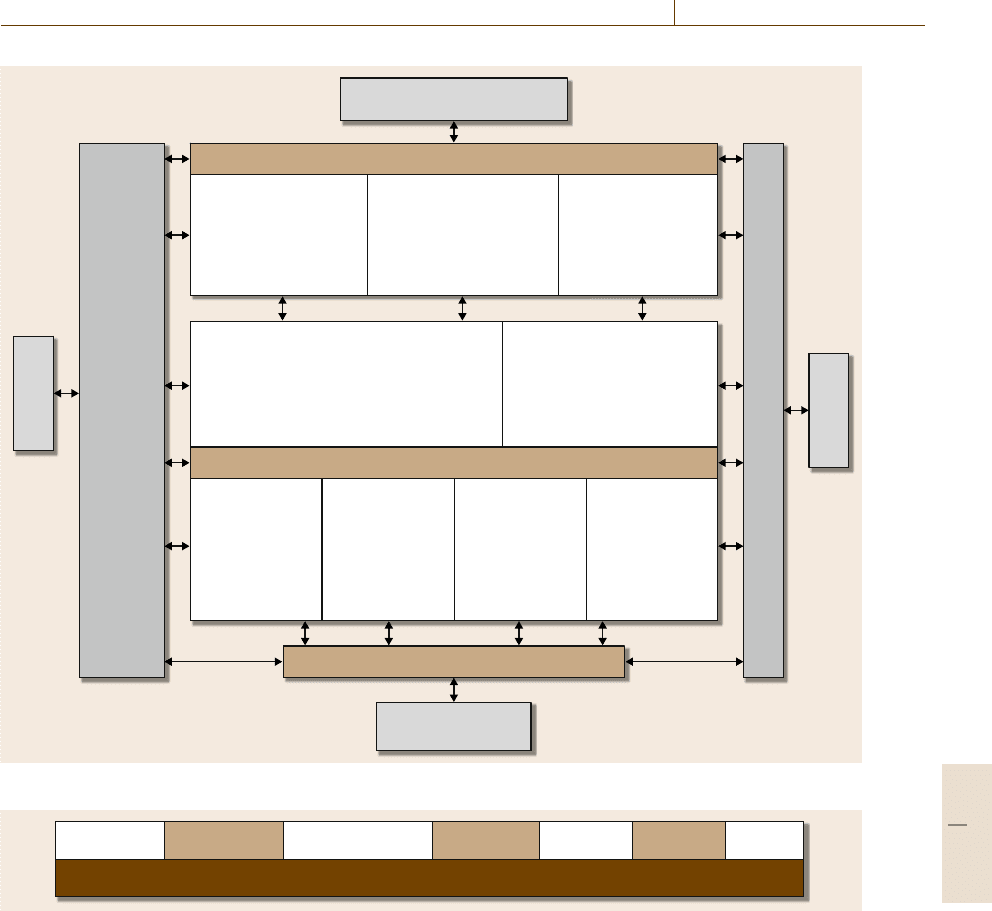
Collaborative e-Work, e-Business, and e-Service 88.1 Background and Definitions 1551
Customers, distributors,
resellers
Customer relationship management
Enterprise requirement planning
Knowledge management
Supply management
Partners,
suppliers
Employees
Enterprise application integration
Stakeholders
• Campaign management
• Catalog management
• Promotion management
• Price
“e-Marketing”
• Sales force automation
• Sales contact, lead
management
• Quote, proposal generation
• Commission management
“e-Sales management”
• Field service
• Call center
• Returns
“e-Customer service”
• Order entry
• Order management
• Configuration
• Available to promise
• Data warehouse
• Decision support systems
• Acknowledgement
• Invoicing
• Payment
• Credit management
“e-Sell”
• Human resources
• Payroll
• Finance
• Maintenance, repair and
operations (MRO)
“e-Manage”
• Demand
planning
• Supply planning
• Forecasting
• Replenishment
• Production plan
“e-Plan”
• Procurement
• Inventory
management
• Strategic sourcing
• Supplier payment
“e-Buy”
• Build to order
• Production
• Manage factory
“e-Make”
• Distribution
management
• Logistics
• Shipping
• Receiving
“e-Move”
Fig. 88.2 e-Business application framework (after [88.7] with permission from Taylor and Francis)
e-Business e-Commerce e-Logistics e-Factory e-Design . . .e-Manufacturing
e-Work
Fig. 88.3 Scope of collaborative e-Work as the common foundation of e-Activities (after [88.8])
implement, and assess the set of activities required to
achieve a common goal, thus jointly creating added
value.
Over the years, computers and advances in commu-
nication technologies and related areas have enabled us
to significantly improve the quality of service and prod-
ucts, as well as the level of customization. Specifically,
collaborative e-Work is revolutionizing the capabilities
of e-Business, e-Production, and e-Service. By lever-
aging existing and well-established work, business and
service models, theories, and solutions with the new
electronic world, it is possible to augment companies’
abilities to significantly better meet customers’ needs.
In the next section, the four knowledge clusters of e-
Work and their related 15 dimensions are discussed in
detail.
Part I 88.1

1552 Part I Home, Office, and Enterprise Automation
Coordination Cooperation
• Communication
• Information
exchange
• Complementary
goals
• Alignment
of activities
• Compatible goals
• Individual identities
• Ability to work apart
Collaboration
• Joint goals, identities
and responsibilities
• Work together
Fig. 88.4 Coordination, cooperation, and collaboration levels of interaction
88.2 Theoretical Foundations of e-Work
and Collaborative Control Theory (CCT)
Collaborative control theory (CCT) has been developed
over the last decade to support the effective design of
collaborative e-Work, e-Business, and e-Service sys-
tems, and includes several design principles [88.9–
11]. Many researchers have contributed to CCT (e.g.,
see survey in [88.3]) and have addressed issues of
collaborative performance. For instance, collaborative
intelligence has been defined as a measure of the col-
laborative ability of an interacting, distributed group or
Active
middleware
e-Work
Distributed
decision
support
Integration,
coordination,
collaboration
e-Work theory
and models
Integration,
coordination and
collaboration
theory and models
Decision
models
Distributed
control
systems
Collaborative
problem
solving
Computer
integrated
manufacturing
Human-computer
interaction (HCl)
Extended
enterprise
Middleware
technology
Grid
computing
Knowledge-
based systems
Distributed
knowledge systems
Agents Workflow Protocols
Fig. 88.5 Collaborative e-Work: foundations, dimensions, and
scope (after [88.3])
organization, whether of humans and/or agents, robots,
sensors, etc. The major tradeoff that CCT addresses is
that with a larger number of collaborating participants
in a more complex, large-scale system; the knowledge
and performance generated from collaborative efforts
can increase proportionally to the reach of the network,
but conversely the number of conflicts, delays, and er-
rors increases too, up to ineffectiveness, reduction in
value, and collapse. To support the collaboration effort,
e-Support is essential so that participants can interact in
real time or asynchronously even though they are not
located within the same physical location. Technolo-
gies used to enhance distributed collaboration and to
facilitate group problem-solving and decision-making
include messaging software, coordination protocols,
task administration protocols, and other e-Support tech-
niques and tools:
1. Group moderation and facilitation
2. Agreement to adhere to a set of fundamental rules
relating to participant interactions
3. Frequent sharing of feedback
4. Frequent service reviews and agreements on
progress and plans
5. Maintenance of a collaborative memory as an orga-
nizational knowledge base
6. Service-oriented architectures for collaborative au-
tomation.
Examples of these developments are discussed
in manufacturing and supply [88.12], in shared un-
Part I 88.2
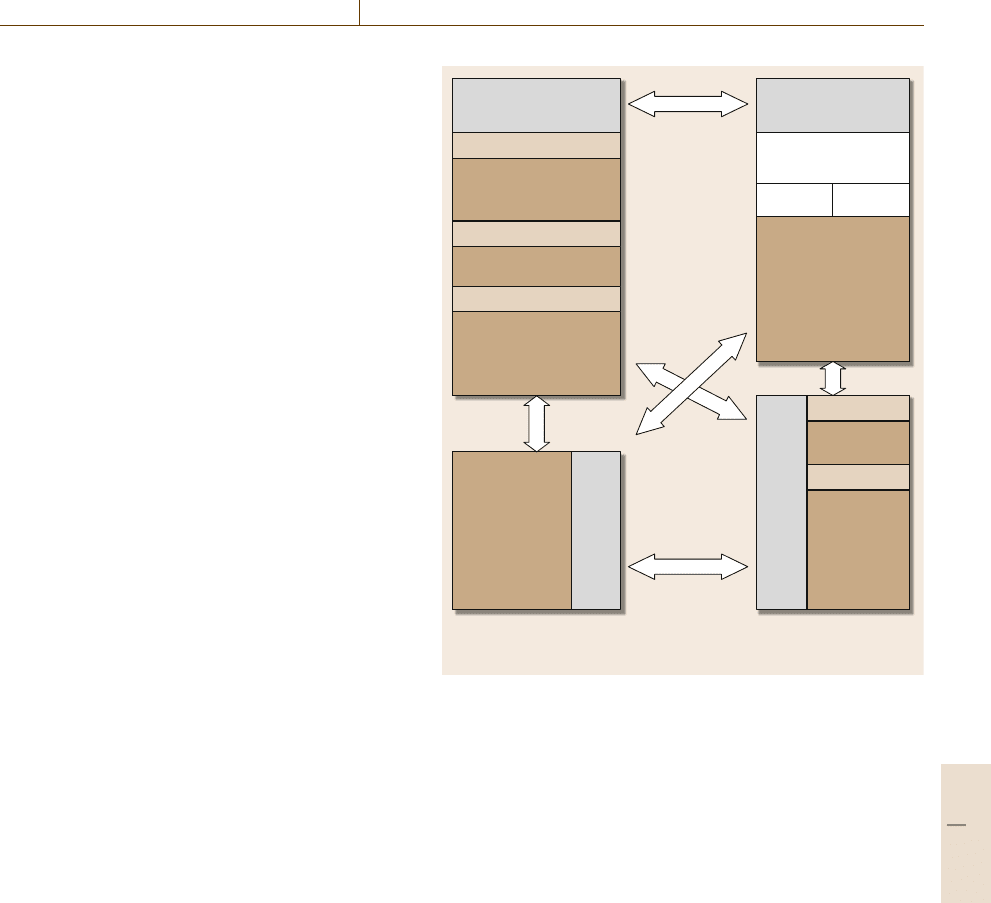
Collaborative e-Work, e-Business, and e-Service 88.2 Theoretical Foundations of e-Work and Collaborative Control Theory (CCT) 1553
derstanding for collaborative control [88.13], and in
multirobot remote activation with collaborative con-
trol [88.14].
The “e” in collaborative e-Work is supported by
the continuous creation of knowledge in four areas and
their overlaps: (1) e-Work, (2) integration, coordina-
tion and collaboration, (3) distributed decision support
systems, and (4) active middleware, all of which in
turn are rooted in 15 e-Dimensions as described below
(Fig.88.5).
The first theoretical foundation area is e-Work itself,
and it comprises four e-Dimensions: (1) e-Work theory
and models, (2) agents, (3) protocols, and (4) workflow,
as described below.
88.2.1 e-Work Theory and Models
Theory and models provide the foundation for the de-
velopment of models to (1) augment human abilities
and capabilities at work, (2) augment organizational
abilities to accomplish their goals, and (3) augment the
abilities of all organizational agents (e.g., human, com-
puters, robots, etc.) for collaboration. Below, several
principles that serve as guidelines and foundation for
effective e-Work are discussed in more detail.
88.2.2 Agents
Agents are independently operating and executing
programs capable of responding autonomously to ex-
pected or unexpected events [88.16]. Agents enable
the automation and integration of flexible, adaptive,
and heterogeneous activities, components, and tasks in
a network. For instance, intelligent information agents
are being used to (1) be proactive in the identifica-
tion of enterprise resources, (2) provide value-added
information for ongoing e-Activities, and (3) reduce the
number of conflicts and errors in the information pro-
vided to and by all members of networked enterprises
(Fig.88.6). The applicability of agents expands a sig-
nificant number of domains, including: autonomous
mobile or stationary robots, electronic information sys-
tems, data mining and data clusters, decision-support
systems, agent-based simulation, and intelligent de-
sign and manufacturing systems. An example of agents
working in a collaborative environment includes the
University of Michigan digital library (UMDL) where
the library’s electronic information and services are
offered in a distributed environment by building on
commerce and communication protocols for agent in-
teraction.
Communication
skills
• I/O Processing
• Human affect signal
sensoring
User
Knowledge
skills
• Ontological
knowledge
• Metadata, profiles
• Formats
• Learning: Genetic,
neural nets,
case/dialog/
memory-based
Self, environmental
knowledge
Acquired A priori
• ACL
Agent
User
Agent
Task level skills
Collaborative skills
• Wrapping
• Access via Web, API,
middleware (TCP/IP,
HTTP, IIOP)
ACL = Agent Communication Language; API = Application Programming Interface;
TCP/IP = Transmission Control Protocol/Internet Protocol; HTTP = Hypertext Transfer Protocol;
IIOP = Internet Inter-ORB Protocol; HAI = Human Agent Interaction; AC = Affecting Computing
Sources
• Retrieval
• Filtering
• Integration
• Visualization
• Purchasing
• Data mining
• Querying
• Conversation
• Negotiation
• Brokering
• Matchmaking
• Social
filtering
• HAI
• AC
Information
Fig. 88.6 Agent-mediated trading: intelligent agents and e-Busi-
ness (after [88.15])
88.2.3 Protocols
Protocols provide an efficient and effective platform
for autonomous entities (such as agents) to inter-
act, be productive, and achieve their goals. Many
different types of coordination protocols have been de-
signed to achieve effective coordination among agents,
such as (1) dependence-based coordination between
tasks [88.17, 18] and (2) decision- and time-based
protocols to better meet requirement changes and
complexscenarios that requiredecisions beyond coordi-
nation [88.19–21]. As an example, Ko and Nof [88.21]
compare a task administration protocol (TAP)which
is a coordination and interruption–continuation pro-
tocol (CICP), with a non-TAP coordination protocol
(CP) to examine which protocol enables better assign-
ment of tasks in a human–robot team under emergency
pressures. They conclude that the performance of
a TAP-based coordination protocol outperforms the
non-TAP coordination protocol according to the ra-
Part I 88.2
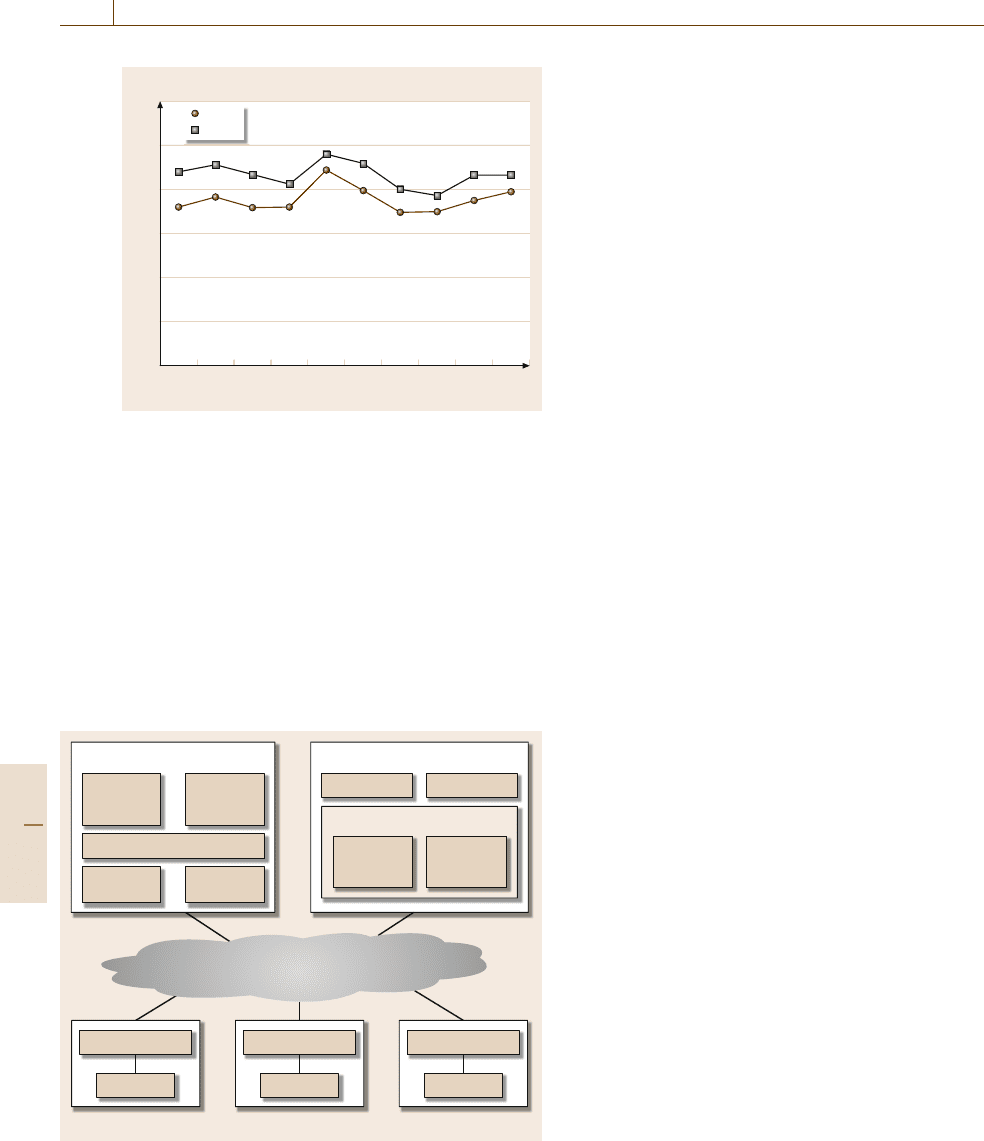
1554 Part I Home, Office, and Enterprise Automation
12345678910
TAR
CP
CICP
r
1.2
1
0.8
0.6
0.4
0.2
0
Fig. 88.7 Task allocation ratio (TAR) for emergency
tasks [88.21]. The task administration protocol (CICP)al-
ways performs better because it is typically at a higher
level of decision intelligence relative to the coordination
protocol (CP)
tio of total unallocated tasks to total number of
allocated tasks (TAR)(Fig.88.7). The protocols of
interest in e-Work are those that function at the ap-
plication level and which determine workflow control.
Protocols at this level enable effective collaboration
by coordinating information exchange and decisions
such as resource allocation among production tasks
Constraint-based broker server
UDDI-enabled registry
UDDI = Universal Description Discovery and Integration
e-Service adapter
e-Services
e-Service adapter
e-Services
e-Service adapter
e-Services
Cost-benefit
evaluation
server
Constraint
satisfaction
processor
Registration
coordinator
Inquiry
coordinator
Dynamic WfMS
Workflow server
ETR server Event server
Workflow
engines
Process
definition
tool
Internet
Fig. 88.8 Dynamic workflow management system (WfMS)archi-
tecture (after [88.22])
to achieve a common goal and jointly generate better
value. The unique advantage of TAPsisinsmarte-
Support and efficient, optimized streamlining of human
collaboration.
88.2.4 Workflow
Workflow captures the systematic assignment and
processing of activities in dynamic, distributed environ-
ments by enabling process scalability, availability, and
performance reliability. Workflow technology has re-
ceived a lot of attention in recent years since it enables
businesses to better manage information and opera-
tions. One recent effort has focused on the design and
implementation of a dynamic workflow management
system to support e-Businesses. The system devel-
oped allows for interenterprise workflow management
using e-Services for a network of collaborating enter-
prises [88.22]. Due to the dynamics of the Internet
and the organizations using it, an organization can join,
leave or remain in acollaborative network withoutmuch
difficulty; however, regardless of the decision of a given
enterprise to join/leave or remain in a collaborative net-
work of organizations, all scenariosrequire that existing
data resources, processes, and services be integrated or
interfaced via workflow models. Their model was the
first attempt to develop a dynamic architecture to better
account for the nature of services and their availability
at different instances in time (Fig.88.8).
The scope of the second theoretical foundation
area includes integration, coordination, and collab-
oration and comprises four e-Dimensions: (1) inte-
gration, coordination, and collaboration theory and
models, (2) computer-integrated manufacturing (CIM),
(3) human–computer interaction (HCI), and (4) ex-
tended enterprises, as described below.
88.2.5 Integration
Integration, coordination, and collaboration theory and
models provide the backbone for (1) identifying exist-
ing and new connectionsbetween informationresources
and processing entities/agents and (2) developing mod-
els and methodologies to enhance the collaborative
activities between participating entities/agents and their
use of information resources. Various approaches have
been used to address the challenges of integration, co-
ordination, and collaboration in the e-World. One of
the best measures to assess the effects of a higher
level of integration, collaboration, and cooperation is
the number of areas being influenced, among them:
Part I 88.2
